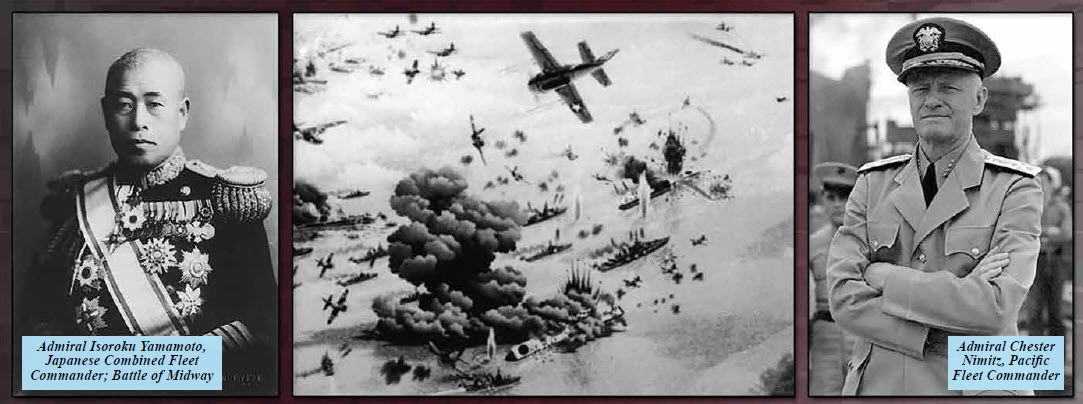Battle of Midway
 By: Sandra Thompson
By: Sandra Thompson
June seems to be a very busy month for battles! Most everyone is aware of D-Day, June 6, 1944, but another battle that changed the war was the Battle of Midway. The Battle of Midway in June1942 was one of the most decisive naval battles in history and the turning point in the Pacific. Between June 4 and 7, aircraft carriers Enterprise, Yorktown, and Hornet ambushed and sank the Imperial Japanese Navy’s carrier force that only six months before had attacked Pearl Harbor. In the six months prior to Midway, the Japanese had captured lands throughout the Pacific, including Malaysia, Singapore, the Dutch East Indies, the Philippines, and numerous island groups. The United States, however, was a growing threat, and Admiral Yamamoto sought to destroy the U.S. Pacific Fleet before it became unstoppable.
A thousand miles from Honolulu, the island of Midway became the focus of Yamamoto’s scheme to smash U.S. resistance. His plan consisted of a feint toward Alaska followed by an invasion of Midway. When the U.S. Fleet arrived at Midway to respond to the invasion, it would be destroyed by the superior Japanese fleet waiting unseen to the west. If successful, the plan would eliminate the U.S. Pacific Fleet. At the root of the American victory at Midway was U.S. Navy intelligence successfully breaking Japanese codes and discovering the Japanese plans to attack Midway.

Station Hypo was the team of U.S. signals intelligence analysts who were aggressively attempting to decipher messages transmitted using the JN-25 code. By late April, this team determined that the Japanese were planning major campaigns targeting the central Pacific and Aleutians. In a famous trick, Admiral Chester Nimitz approved a ruse proposed by Hypo that saw the garrison at Midway send a fake message “in the clear” regarding broken water evaporator units on the island. Almost immediately, American listening posts intercepted Japanese transmissions mentioning the water shortage and the need to bring along extra water to support the operation. The identity of the Japanese objective was conclusively determined as Midway.
Lieutenant Commander Edwin Layton recounted presenting the fruits of Hypo’s work on May 27 at the Pacific Fleet staff conference where the U.S. plans to ambush the Japanese force near Midway were approved, giving Nimitz a stunningly predictive assessment: “Summarizing all my data, I told Nimitz that the carriers would probably attack on the morning of 4 June, from the northwest on a bearing of 325 degrees. They could be sighted at about 175 miles from Midway at around 0700 local time.” On the morning of the battle, as the initial American reports sighting the Japanese force began to trickle in, Nimitz remarked to Layton with a smile, “Well, you were only five minutes, five degrees, and five miles out.” Layton’s assessment allowed Nimitz to take a calculated risk by devoting three of his precious aircraft carriers (still scarce at that stage of the war) to the battle. The foreknowledge justified the presence of the USS Yorktown at Midway. USS Yorktown, damaged at the Battle of Coral Sea, was rushed back into action after a few days of frantic repairs at Pearl Harbor
Based on Hypo’s analysis, two U.S. attack fleets caught the Japanese force entirely by surprise. In the early morning hours of June 4, Japan deployed 108 warplanes from four elite aircraft carriers in the vicinity. Although the Japanese inflicted serious damage on both the responding American fighters and the U.S. base at Midway, the island’s airfield and runways remained in play. The Americans counterattacked with 41 torpedo bombers flown directly toward the four Japanese carriers. Thirty-five of the bombers were lost along with their crews. Those men went into this fight knowing that it was highly likely they would never come home,” says Laura Lawfer Orr, a historian at the Hampton Roads Navel Museum. “Their bombers were obsolete. They had to fly incredibly slowly and awfully close to the water. Plus, they had torpedoes that, most of the time, did not work.”
The sacrifice of the torpedo bombers brought Japanese fighter cover over their carriers down to the water. This allowed dive bombers to sink three Japanese carriers in five minutes, changing the course of WWII. When the Battle of Midway ended, Japan had lost four carriers, a cruiser and 292 aircraft, and suffered an estimated 2,500 casualties. The U.S. lost the USS Yorktown, the destroyer USS Hammann, 145 aircraft, and suffered approximately 300 casualties.
By: Sandra Thompson
Director, Alabama Veterans’ Museum